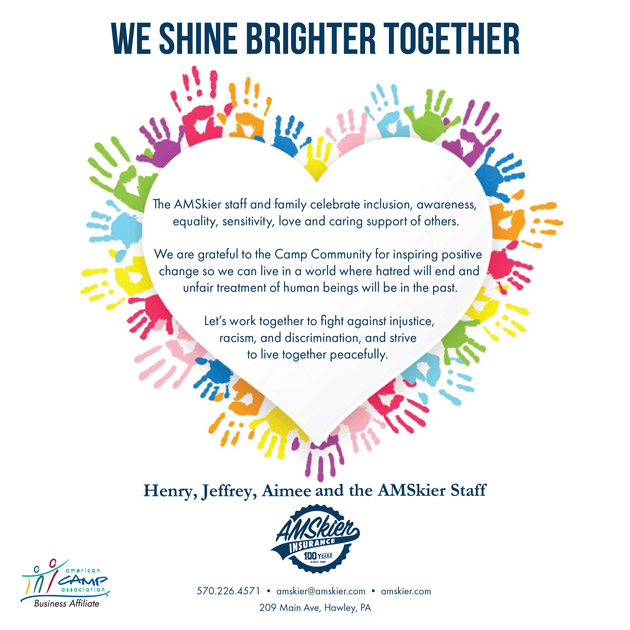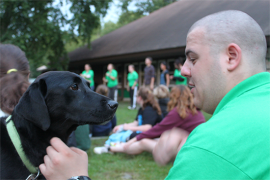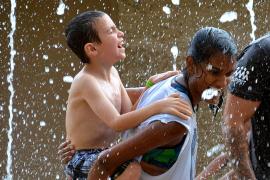In January 2016, I decided to bring my assistant to the ACA National Conference in Atlanta. We both agreed it would be a way for her to gain a deeper understanding of my work with camp professionals. Not only would she help me organize my presentations and handouts, but she would get to see me in action and develop a greater sense of my “audience” and what people were looking for from my work.
While we were there, she got to meet many of the camp professionals from all parts of the country I’ve worked with and come to know so well. She also sat in with a group of up-and-coming camp professionals I had put together the previous year in what we called the “Dolphin Tank” — a combination support-learning-study group that met under my guidance once a month for several years in New York.
After a few days at the conference, I asked my assistant about her experience to that point. She said it was great to see me speak and to meet so many people committed to bettering the lives of children through camp. And then she said, “But there’s hardly anyone here who looks like me!” Did I mention that my assistant, Ayanna, is Black?
Indeed, go to most any camp conference or to many (not all) camps in the United States, and what you will see is a sea of white people. Over the years, I have heard many reputable, well-intentioned camp professionals talk about how they would love to have more counselors or campers of color, but they have little or no clue about how to find them. I believe these folks are sincere and I can hear the helplessness in their voices when they say these things. They want to know what they can do to change things.
What I have learned in the past several years as a board member of Boston Explorers, an urban day camp for kids, is that even if you were to “find” people of color, it is not clear that they would feel welcome or stay if you invited them to your camp. Would there be, for example, other people there who looked like them? Would there be an awareness — cultivated through a willingness and openness to know — of how we often slight people of color in ways we are sometimes oblivious to? And would Black child care professionals feel welcome enough at a local, regional, or national camp conference because we, the majority — did I mention that I am white? — have not taken the time to create environments where they would feel truly seen and acknowledged as equals?
As Beverly Daniel Tatum points out in her book Why Are All the Black Kids Sitting Together in the Cafeteria?, until we understand the subtle and not-so-subtle ways we ignore the specific needs and experiences of Black people, they aren’t going to feel seen or heard — validated — or want to be a part of camp, either as an organized movement or at individual camps (Tatum, 1997).
Indeed, in her prescient article, written just months before the protests following the George Floyd killing in Minneapolis, Michelle Alexander pointed out that until white people (who are clearly the majority in most camp settings) face and understand “the deep denial” we collectively have about the many ways we make Black people feel unwelcome because we are oblivious to our own racial biases, how will they ever feel they can trust the welcome we might extend to them (Alexander, 2020)? As white folks, we can conveniently ignore the way Black and brown people have persistently and systematically been branded “a problem” (Du Bois, 1987). We must do our homework — read and speak with people of color and visit places like the National Museum of African American History and Culture in Washington, DC, or Howard University or Morehouse College. Not to recruit, but simply to listen to what it is like to be a young Black man or woman (or nonbinary person of color) and navigate a world where white people are the majority and hold power. Until then, we will never succeed in creating environments in which everyone feels safe from the slights and indignities of racism, even if those slights are unintended.
Questions to Ask Black College Students about Camp
- What experiences have you had at camp, either as a camper or staff member?
- Were your experiences positive or not, and what made them so?
- What would you need a camp community to know or understand for you to feel comfortable working there as a staff member?
- What can I do to create an environment at camp that is welcoming for campers and counselors of color?
The protests that have followed the George Floyd killing in Minnesota ushered in an urgency and a hopefulness that has persisted about how to address the racial divide in the United States. I am overwhelmed by what I still need to learn — about what I would like all of us in camp to learn — to create places where children and young people of color have the same access to quality camp experiences that many white children take for granted. I know I can’t do this topic justice, and I feel intimidated by the enormity of it. Yet, I feel that if I don’t write something, the moment will be lost.
As Tatum says, “The task for each of us, white and of color, is to identify what our own sphere of influence is (however large or small) and to consider how it might be used to interrupt the cycle of racism” (Tatum, 1997). One way I can do this is to share some insights and awareness I have acquired in the past few years working with the children, teens, and counselors, as well as the adults, associated with Boston Explorers. While I still have a lot to learn, I hope I can find the humility and grace to keep at it.
Clarifying Some Terms and Phrases
One step in understanding what Black people experience in a predominantly white society is to learn how the things we say often show a complete lack of understanding of the complexity and enormity of our racism. Here are a few.
“I Am Not a Racist”
A lot of white people blurt out this phrase without realizing that, as Tatum says, “racism is in the air we breathe. What people who hold power need to ask is, ‘What have I done to create an environment that is welcoming to people who are marginalized?’” (Tatum, 2017). We may not wish anyone of another race any intentional harm, but we unintentionally harm or slight people of other races (or even of other identities, such as LGBTQ) many ways without being aware of the negative impact our behavior carries. This gets into the matter of being an active racist and a passive racist.
An active racist behaves in a way that deliberately causes harm to a person of another race. We see this in members of the Klu Klux Klan or other white supremacists. The harm can be from physical, verbal, or economic violence; or it can be in the way Black people have been systematically and persistently denied access to resources that would allow them to thrive. Active racists then create a pernicious narrative about the race being harmed that makes it seem as if they deserve the harm because, according to the narrative, “they brought it on themselves.”
A passive racist, on the other hand, stands by and does nothing when an active racist does or says something that is intentionally harmful. Until recently, most white people have done nothing to change the way Black people have been victimized, marginalized, demonized, incarcerated, or otherwise restricted. As Amy Harmon and Audra Burch note, “The outcry over Mr. Floyd’s death has compelled many white Americans to acknowledge the anti-Black racism that is prevalent in the United States — and to perhaps even examine their own culpability in it. It is as though the ability of white people to collectively ignore the everyday experience of Black people has been short-circuited, at least for now” (Harmon & Burch, 2020).
At camp, for example, when a white camper says something to a Black camper, like, “Are you on scholarship here?” which implies that a Black family could not possibly have the means to send their child to camp, and not one counselor steps in, that is passive racism.
Or when a white camper says to her Black counselor, “Does your family ever run out of food stamps?” and no one addresses this slight, no matter how naïve the child is who says it, it is passive racism. As Ibram X. Kendi says in his book How to Be an Antiracist, until we address racism when we see it, it will persist (Kendi, 2019).
“All Lives Matter!”
This is sometimes a response to the “Black Lives Matter” movement. The statement misses the point. Of course, all lives should matter! However, as long as Black people are consistently and persistently harassed, arrested, and killed by police (and in far greater numbers than their white counterparts); are systematically denied access to the means for acquiring home ownership, quality education, quality jobs, promotions, equal justice, or affordable health care; and are survivors of a injurious narrative about their supposedly subhuman status, then clearly black lives don’t yet matter, which means that all lives clearly don’t matter!
White Privilege
Many white people bristle at this phrase because they think it negates any or all the work and effort they may have put into achieving what they have, whether it be their job, a college or advanced degree, home ownership, wealth, security, and so on. The difference is that white people have access to a system wherein we can achieve these things. Furthermore, many of us have no idea the of slights — big and small — that Black people endure every day. As a white man, when I go into a store, I don’t usually worry about carrying out a receipt for fear that I will be stopped and accused of shoplifting. When I walk down the street, women don’t cross to the other side to avoid me. My parents never had to give me “the talk” about where to place my hands, what tone of voice to use, and how to check my rage when (not if) I am stopped by a police officer because I “look like I don’t belong in this neighborhood,” or I “look like someone who held up a store several blocks from here” (Ditter, 2016; Alcindor, 2012). When I show up at a new job on the first day, I am not mistaken for the cleaning person because of the color of my skin (Carver and Livers, 2002).
One of the greatest privileges of being white is that I never have to think about the fact that I am white. Black people, however, can never stop being aware of being Black, because it is a matter of survival. As psychologist Susan Friske once said, “People pay attention to those who control their outcomes. In an effort to have some influence over those outcomes, people gather information about those in power” (Friske, 2010). Indeed, Black people have had to learn how to navigate a predominately white world, not giving their predominantly white teachers, principals, college admissions personnel, bosses, supervisors, camp directors, and police officers even the slightest reason to hold them back or worse. I have the privilege of not having to trouble myself with the things Black people must endure every day, because it does not affect me directly. And seldom, if ever, do I find myself the only white person in a crowd of mostly Black people. This is the heart of my white privilege, and not having to know this is at the core of that privilege.
Beyond Police Brutality: The Long-Standing Racial Divide
While it is critical that we as a country look at the racial profiling, harassment, detention, and killing of Black people at the hands of police, which is an entrenched, grievous, and urgent issue, racism does not end there. For white camp professionals to truly appreciate and welcome Black campers and counselors, we must develop a greater awareness of the long history of inequality in this country. My suggestion is to start with the aforementioned African American history museum in DC when it is open again. How is it that I learned nothing in school about how the economy of this country as well as that of others is founded on Black slave labor dating back to 1619? Or that after the Civil War, which never really ended for Black people, we systematically and perniciously continued to marginalize and vilify Black people. No wonder many Black people wonder why it took that video of George Floyd to get our attention when it has been going on since the inception of the country (Coates, 2014).
Those Poor Underprivileged Kids
I once attended a fundraising event in a major US city for a nonprofit organization that did a lot of great work with youth who came from under-resourced zip codes. The tone of the speakers who were trying to get people to donate was troubling to me. As long as we think of Black children as “underprivileged,” or “at risk,” we will perpetuate a narrative that brands them as “a problem.” How would you like to be a parent whose child is referred to as “at risk”? Black children have the same curiosity about the world, the same yearning to connect meaningfully with friends; they show the same exuberance for camp and love the company of interesting, appropriate young adults just as any children do. To think of them otherwise is to categorize them as less than, which is what racists believe.
Six Practices for Creating Deeper Dialogue and Greater Understanding
Just as there is no formula for relationships (even though there are things we can do to improve our chances of having more fulfilling relationships), there is no formula for raising awareness. Relationships, and the expansion of our awareness that comes from having them, are a messy, imperfect, emotionally laden undertaking! That said, I do suggest these practices that will help us learn from one another’s experiences
1. Listen without judgment. This requires suspending our tendency to become judgmental or defensive when we hear someone whose experience or perspective is different from ours. The only way to truly comprehend someone else is to try to step into their shoes to listen to and take in their experience as they relate it to you
2. Replace judgment with curiosity. When someone says something you don’t understand or that is different from your experience or anything you know, it does not negate your experience. The best way to go deeper is to become curious: ask good clarifying and probing questions. Ask someone to share the thinking behind their statements or conclusions; ask someone to expand on their thinking when they us a label (“Tell me what you mean by…”)
3. Understand the difference between intention and impact. Someone might have the best of intentions in making a comment they think is helpful or affirming, yet the person on the receiving end may hear it as ignorant or hurtful. I once referred to a writer and speaker I admired, Enid Lee, as “an articulate Black woman.” I thought I was conveying my respect for her. Someone asked me if I would have said, “articulate white woman.” No, in all honesty, I probably wouldn’t have. To some people, my referring to her race made it sound as if I was surprised to find a Black woman who was articulate. My positive intention had a negative impact that I couldn’t see until someone else pointed it out. To learn about our unintended yet harmful impacts, we must be willing to be humble and hear the harm we may be doing, even if we don’t mean to.
4. Practice “radical acceptance.” One of the most powerful forms of validation is something behavioral therapists call “radical acceptance.” Radical acceptance is when you don’t always agree, endorse, or like what someone else is saying and you can still understand where they are coming from.
5. Step outside the conversation and talk about how you are talking. One of the best practices in developing trusting, open dialogue is to talk about how you are talking. Do you both feel you are listening? Do you feel you are getting too emotional, and, if so, what might be making that happen? What can you think about together to help you listen less defensively? Talking about talking can also help signal when to take a break or to think about how to get a conversation into a more productive space.
6. Start with something you can both agree on. This would be your common ground. Beginning from a place of agreement gets the conversation started and helps people say, “This is what we both want.” Sometimes you find you want the same things; you just disagree about how to get there.
The problem of racism is a white problem. This is as true in the world of camp as it is in the rest of the country. If we truly want to invite people of color into the camp movement, we need to face and understand the longstanding racism in our history. Only after we get past our denial, acknowledge our white privilege, and listen to Black people’s experiences will we be able to see camp as a place where everyone can feel safe to be their true self.
References
Alcindor, Y. (2012, April). Parents recall having ‘the talk.’ USA Today. Retrieved from usatoday30.usatoday.com/NEWS/usaedition/2012-04-20-the-talk_ST_U.htm
Alexander, M. (2020, January 17). The injustice of this moment is not an aberration. The New York Times. Retrieved from nytimes.com/2020/01/17/opinion/sunday/michelle-alexander-new-jim-crow.html
Carver, K. A. & Livers, A. B. (2002, November). Dear white boss. Harvard Business Review. Retrieved from hbr.org/2002/11/dear-white-boss
Coates, T. (2014, June). The case for reparations. The Atlantic. Retrieved from theatlantic.com/magazine/archive/2014/06/the-case-for-reparations/361631/
Burghardt Du Bois, W. E. (1987, August). Strivings of the negro people. The Atlantic. Retrieved from theatlantic.com/magazine/archive/1897/08/strivings-of-the-negro-people/305446/
Ditter, B. (2016). “A greater understanding of children of color,” Next Generation Camp Leadership, pp. 66–72. Monterey, CA: Healthy Learning.
Friske, S. (2010). Social beings: A core motives approach to social psychology. Hoboken, NJ: Wiley.
Harmon, A. & Burch, A. D. S. (2020, June 22). White Americans say they are waking up to racism. What will it all add up to? The New York Times. Retrieved from nytimes.com/2020/06/22/us/racism-white-americans.html
Kendi, I. X. (2019). How to be an antiracist. New York, NY: One World.
Tatum, B. D. (2017, May 19). Is my skin brown because I drink chocolate milk? TEDx Stanford. Retrieved from Error! Hyperlink reference not valid.Tatum, B. D. (1997). Why are all the black kids sitting together in the cafeteria, and other conversations about race. New York, NY: Basic Books.
Bob Ditter is a licensed clinical social worker specializing in child, adolescent, and family therapy.




